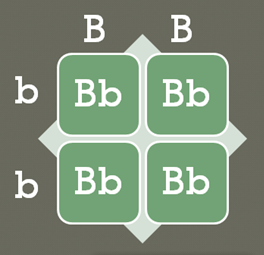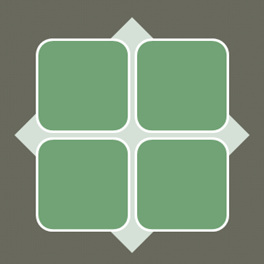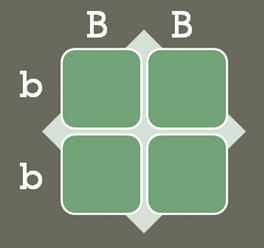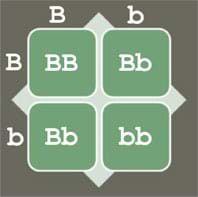Quick Look
Grade Level: 10 (9-11)
Time Required: 45 minutes
Lesson Dependency: None
Subject Areas: Chemistry, Life Science, Physical Science
NGSS Performance Expectations:

| HS-LS3-3 |

Summary
After watching video clips from the Harry Potter and the Goblet of Fire movie, students explore the use of Punnett squares to predict genetic trait inheritance. The objective of this lesson is to articulate concepts related to genetics through direct immersive interaction based on the theme, The Science Behind Harry Potter. Students' interest is piqued by the use of popular culture in the classroom.Engineering Connection
Engineers must understand trait inheritance for the genetics research that applies to medical diagnoses and treatment, crop modification, cloning and stem cell research. For example, engineers apply nanotechnology for genetics by making use of DNA, a nucleic acid that carries the genetic information in a cell, to medical diagnosis. They combine nanosized probes with DNA sequences or antibodies to form a nanosystem that detects specific DNA sequences in the body as a way to detect genetic diseases long before they become problematic. Similar to drug delivery, gene therapy could be implemented through nanocapsules.
Learning Objectives
After this lesson, students should be able to:
- Describe a trait and give examples.
- Understand the relationship between alleles and heterozygous and homozygous traits.
- Create a 2 x 2 Punnett square and predict traits passed from parents to children.
- Describe nanotechnology research and engineering in genetics.
Educational Standards
Each TeachEngineering lesson or activity is correlated to one or more K-12 science,
technology, engineering or math (STEM) educational standards.
All 100,000+ K-12 STEM standards covered in TeachEngineering are collected, maintained and packaged by the Achievement Standards Network (ASN),
a project of D2L (www.achievementstandards.org).
In the ASN, standards are hierarchically structured: first by source; e.g., by state; within source by type; e.g., science or mathematics;
within type by subtype, then by grade, etc.
Each TeachEngineering lesson or activity is correlated to one or more K-12 science, technology, engineering or math (STEM) educational standards.
All 100,000+ K-12 STEM standards covered in TeachEngineering are collected, maintained and packaged by the Achievement Standards Network (ASN), a project of D2L (www.achievementstandards.org).
In the ASN, standards are hierarchically structured: first by source; e.g., by state; within source by type; e.g., science or mathematics; within type by subtype, then by grade, etc.
NGSS: Next Generation Science Standards - Science
| NGSS Performance Expectation | ||
|---|---|---|
|
HS-LS3-3. Apply concepts of statistics and probability to explain the variation and distribution of expressed traits in a population. (Grades 9 - 12) Do you agree with this alignment? |
||
| Click to view other curriculum aligned to this Performance Expectation | ||
| This lesson focuses on the following Three Dimensional Learning aspects of NGSS: | ||
| Science & Engineering Practices | Disciplinary Core Ideas | Crosscutting Concepts |
| Apply concepts of statistics and probability (including determining function fits to data, slope, intercept, and correlation coefficient for linear fits) to scientific and engineering questions and problems, using digital tools when feasible. Alignment agreement: | Environmental factors also affect expression of traits, and hence affect the probability of occurrences of traits in a population. Thus the variation and distribution of traits observed depends on both genetic and environmental factors. Alignment agreement: | Algebraic thinking is used to examine scientific data and predict the effect of a change in one variable on another (e.g., linear growth vs. exponential growth). Alignment agreement: Technological advances have influenced the progress of science and science has influenced advances in technology.Alignment agreement: Science and engineering are influenced by society and society is influenced by science and engineering.Alignment agreement: |
Common Core State Standards - Math
-
Find the conditional probability of A given B as the fraction of B's outcomes that also belong to A, and interpret the answer in terms of the model.
(Grades
9 -
12)
More Details
Do you agree with this alignment?
-
(+) Analyze decisions and strategies using probability concepts (e.g., product testing, medical testing, pulling a hockey goalie at the end of a game).
(Grades
9 -
12)
More Details
Do you agree with this alignment?
International Technology and Engineering Educators Association - Technology
-
Students will develop an understanding of the role of society in the development and use of technology.
(Grades
K -
12)
More Details
Do you agree with this alignment?
State Standards
Texas - Science
-
Organisms and environments. The student knows that reproduction is a characteristic of living organisms and that the instructions for traits are governed in the genetic material. The student is expected to:
(Grade
7)
More Details
Do you agree with this alignment?
-
recognize that inherited traits of individuals are governed in the genetic material found in the genes within chromosomes in the nucleus.
(Grade
7)
More Details
Do you agree with this alignment?
-
compare the results of uniform or diverse offspring from sexual reproduction or asexual reproduction; and
(Grade
7)
More Details
Do you agree with this alignment?
-
define heredity as the passage of genetic instructions from one generation to the next generation;
(Grade
7)
More Details
Do you agree with this alignment?
Worksheets and Attachments
Visit [www.teachengineering.org/lessons/view/uoh_hp_lesson_square] to print or download.Introduction/Motivation

(Be ready to show students a video clip from Harry Potter and the Goblet of Fire movie.)
A trait is a genetically determined characteristic or condition. That means that it is some sort of characteristic passed down from parents to children. Examples are eye colors and nose shapes. What are some other examples of traits? In people, animals, plants? (Listen to student ideas.) Some other human examples include hair color, height, earlobes (attached or not), dimples, cleft chin, tongue rolling, and tendency for certain inherited diseases or other physical conditions. In plants, herbicide tolerance, virus tolerance, nutritional content, disease or insect resistance, other qualities like taste or ripening time.
Can you think of some magical traits found in the Harry Potter series? (Write these on the board.) Many magical creatures exist in Harry Potter's world. Let's watch a video clip showing the dragons from Harry Potter and the Goblet of Fire. While we are watching the clip, pay attention to look for dragon traits. (Show a video clip from of the scene when Harry is trying to capture a golden egg from a dragon.)
What are some dragon traits? (Possible answers: The ability to speak parseltongue, which is being able to speak to snakes.)
It is possible to predict the likelihood of a child inheriting a trait from a parent using something called a Punnett square. (Proceed to present students with the content information found in the Background section.)
Lesson Background and Concepts for Teachers
Punnett Squares

One of the easiest ways to calculate the mathematical probability of inheriting a specific trait was invented by an early 20th century English geneticist named Reginald Punnett. His technique employs what we now call a Punnett square, which is a simple graphical way of discovering all of the potential combinations of genotypes that can occur in children, given the genotypes of their parents. It also shows us the odds of each of the offspring genotypes occurring.
To create a Punnett square, draw a grid of perpendicular lines. Write the genotype of one parent across the top and that of the other parent down the left side (see Figure 1). It is conventional to use capital letters to indicate dominant alleles (such as B) and lower-case letters (such as b) to indicate recessive alleles. If a parent contributes identical alleles (such as BB or bb) it is called a homozygous trait; if the alleles are not identical, we call it a heterozygous trait (such as Bb or bB, also called a carrier).
Write the genotype of one parent across the top and that of the other parent down the left side.
Then, fill in the boxes of the Punnett square by copying the row and column letters across or down into the empty squares (see Figure 2). This gives us the predicted frequency of all of the potential genotypes among the offspring each time reproduction occurs. Thus, in the Figure 2 example with one parent contributing a BB genotype and the other contributing a bb genotype, the probability of an individual offspring's having the genotype BB is 0%, Bb is 100% and bb is 0%. Because the B trait is dominant, the phenotype of all the possible offspring is B.

Looking at the Figure 3 example, crossing two heterozygous parents (both with the genotype Bb), each can produce either a B or b allele. Thus, the probability of an individual offspring from these parents having the genotype BB is 25%, Bb is 50%, and bb is 25%. For classical dominant/recessive genes, the dominant allele masks the recessive one. Thus, in the Figure 3 example, because the B trait is dominant, there is a 75% chance for the appearance of the dominant phenotype (B), of which two-thirds are heterozygous (Bb), and a 25% chance for the appearance of the recessive phenotype (bb).

Engineering Applications and Nanotechnology Connection
Studying and understanding genetics is of interest to many people, including doctors, medical researchers, biologists, anthropologists, parents and engineers. Engineers must understand genetic trait inheritance to design insect-repellant crops, genetically modify food, help advance technology for medical diagnoses and treatment, and conduct cloning and stem cell research.
Genetic engineers have developed techniques to manipulate gene sequences in plants, animals and other organisms to express specific traits. They develop ways to alter genes to create organisms that provide benefits such as cows that produce larger volumes of meat, fuel- and plastics-generating bacteria, and pest-resistant crops.
In addition to characteristics such as hair color and height, the tendency for certain diseases can be passed down from generation to generation. Many of these are common diseases such as asthma, cancer and diabetes. Many of the applications nanotechnology has for genetics are associated with and/or directly make use of DNA, a nucleic acid that carries the genetic information in a cell.
One example application relates to medical diagnoses. Researchers combine nano-sized probes with DNA sequences or antibodies to form a nanosystem that detects specific DNA sequences in the body. Detecting DNA sequences could allow researchers to detect genetic diseases long before they become problematic enabling early treatment and possibly a better prognosis. . As another example, one similar to drug delivery, gene therapy could be administered through nanocapsules.
Vocabulary/Definitions
allele: One member of a pair (or series) of genes that occupies a specific position on a specific chromosome.
DNA: A nucleic acid that carries genetic information in the cell.
genotype: The genetic composition of an organism.
heterozygous: Having different alleles.
homozygous: Having the same alleles.
inherit: To receive a trait from an ancestor.
phenotype: The observed characteristic of an organism.
Punnett square: A diagram tool used to predict trait inheritance.
trait: A genetically determined characteristic or condition.
Assessment
Questions/Answers: Begin the lesson by asking students: What is a trait? What are examples of traits?
Worksheet: At lesson end, have students complete the Harry Potter Punnett Square Worksheet. Review their answers to gauge their understanding of the concepts. As a class, go over the worksheet answers to make sure students understand the odds calculations and the heterozygous-homozygous concept.
Questions/Answers to ask students after completing worksheet: After students complete the Punnett Square worksheet, and have an understanding of how likely traits are to be passed on and expressed at the individual level, the teacher should explain that a "genetic population" is the sum of all gene (or allele) frequencies represented in a given population. We've learned about dominant traits, but it's important to realize that dominant traits are not always common; the ability to speak Parseltongue is a good example. In Harry Potter we learn that the ability to speak Parseltongue is very rare. Let's say that one in every 100 wizards in a given population can speak Parseltongue.
Ask the class: What kinds of things would have to happen in order to change the percentage of the population who speak Parseltongue over time? (Examples of acceptable answers include: foreign wizards who can speak Parseltongue would have to immigrate into the population from other places, or a disproportionate number of Parseltongue-speaking wizards would have to emigrate away from that population, or die out, or if this was a desirable trait, then wizards with the ability might have better luck finding mates, and therefore the frequency of the population with the ability would increase over generations. Also, genetic mutations might occur that either increase or decrease the occurrence of this trait or the ability of one possessing it to reproduce.)
Now ask the class: "Do you think a small population or a large population would be more likely to experience changes in the frequency of genetic traits over time? Why?" (Answer: small populations are much more susceptible to changes in the frequency with which genetic traits occur over time. If only one percent of wizards can speak Parseltongue, a population of 100 wizards would only have one wizard with the Parseltongue trait, and that trait could vanish from the population if the Parseltongue-speaking wizard dies without reproducing or moves away. A much larger population, say 10,000 wizards, would have 100 Parseltongue-speaking wizards and so changes in the frequency of Parseltongue speakers would be much smaller if a few of those wizards left the population.)
Ask the class: Who would want to (or need to) understand about genetics? And why? (Example answers: Doctors, medical researchers, biologists, anthropologists, parents, engineers. Genetic engineers have developed techniques to manipulate gene sequences in plants, animals and other organisms to express specific traits. Engineers must understand trait inheritance for the genetics research that they conduct to help advance technology in areas such as medical diagnoses and treatment, crop modification, and cloning and stem cell research. They develop ways to alter genes to create organisms that provide benefits such as cows that produce larger volumes of meat, fuel- and plastics-generating bacteria, and pest-resistant crops.)
Additional Multimedia Support
Borrow from your school or public library a DVD of the Harry Potter and the Goblet of Fire movie so you can show students a clip. If not available, describe the scene, since most students are familiar with the movies and will be able to recall the scene and describe it more fully to other classmates.
Use Science Primer's interactive "Punnett Square Calculator" for its good visuals and for additional exploration and/or extension for students and teachers. See http://scienceprimer.com/punnett-square-calculator
Subscribe
Get the inside scoop on all things TeachEngineering such as new site features, curriculum updates, video releases, and more by signing up for our newsletter!More Curriculum Like This

Under the "The Science Behind Harry Potter" theme, a succession of diverse complex scientific topics are presented to students through direct immersive interaction. Student interest is piqued by the incorporation of popular culture into the classroom via a series of interactive, hands-on Harry Potte...

Students explore the relationships between genetics, biodiversity and evolution through teacher-presented material that includes explaining two Punnett square examples to see the probability of freckles in offspring from parents who have and do not have freckles. Learning this information about prob...

Students randomly select jelly beans (or other candy) that represent genes for several human traits such as tongue-rolling ability and eye color. Then, working in pairs, students randomly choose new pairs of jelly beans from those corresponding to their own genotypes. The new pairs are placed on too...

In a class discussion format, students are presented with background information about basic human genetics.The number of chromosomes in both body cells and egg and sperm cells is covered, as well as the concept of dominant and recessive alleles.
References
Genotype. Last updated March 12, 2013. Wikipedia, The Free Encyclopedia. Accessed March 12, 2013. http://en.wikipedia.org/wiki/Genotype
Miller, Jason. Nanotechnology and Genetics. August 1, 2005. Accessed 23 June 2010. http://nanopedia.case.edu/NWPrint.php?page=genetics
Monohybrid cross. Last updated March 12, 2013. Wikipedia, The Free Encyclopedia. Accessed March 12, 2013. http://en.wikipedia.org/wiki/Monohybrid_cross
Punnett square > Monohybrid cross. Last updated March 12, 2013. Wikipedia, The Free Encyclopedia. Accessed March 12, 2013. http://en.wikipedia.org/wiki/Punnett_square
Copyright
© 2013 by Regents of the University of Colorado; original © 2010 University of HoustonContributors
Rachel Howser; Christine HawthorneSupporting Program
National Science Foundation GK-12 and Research Experience for Teachers (RET) Programs, University of HoustonAcknowledgements
This digital library content was developed by the University of Houston's College of Engineering under National Science Foundation GK-12 grant number DGE-0840889. However, these contents do not necessarily represent the policies of the NSF and you should not assume endorsement by the federal government.
Last modified: September 5, 2017









User Comments & Tips